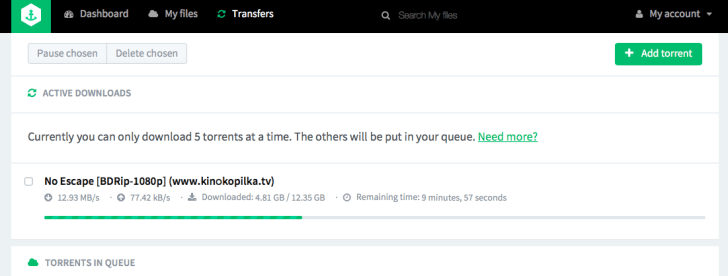If you need to safely obtain files from torrent at great rate and not having to setup any software on your machine you can take advantage of such torrent service like Bitport.io.
The challenge
Even though BitTorrent is far more famous for sharing illegal media than other means, it does have a number of really lawful applications. You will discover a quite a few heavy computer files such as Linux ISO’s that have been accessible on Torrent for a long time and some game creators also using torrents for distributing their fixes and improvements. BitTorrent has been about for more than a 10 years and is merely a method used to publish files on the Web and it’s a shame when one mentions the word, it’s connected to piracy.
A number of university or college networks, company networks and at present even Internet Service Providers are completely stopping or throttling surfers from downloading using Torrent since it is able to suck up great amounts of bandwidth, leaving little or no bandwidth for other users. Or what if one can download torrents ok, but merely don’t want to setup a client such as uTorrent or Deluge on his system simply because he might not going to use it that regularly?
Torrent service as a remedy
One method to download a torrent file without using a torrenting program is by doing it having simply your web browser. This has 2 pros, one of these is there’s no need to run or setup any applications on your computer. And next, it can likewise deal with any limitations enforced on you by your employer, college or internet provider.
If you’re a MAC-user, you can use Folx for best experience while downloading, creating and searching torrents. Otherwise, another solution is Bitport.io, a torrent service allowing you to obtain files out of BitTorrent without the need for installing a torrent application on your machine. It will look for, transfer, and stream the torrents to your machine, all with a stupid degree of safety and simplicity.
Using Bitport is pretty straightforward. Once you’ve got an account, you log in a web dashboard, from where the magic happens. You’re able to connect to a torrent file or magnet link, or upload a file by yourself. The torrent is downloaded (you can download a bunch at the same time, or queue downloads for later), and when the file is saved in the private cloud storage account, you can grab it, or more probable simply stream the file on the internet.
To torrent the file on the web has a few major benefits for the user. The big one is speed: because the torrent is being received by a server located in a data center, everything happen much swifter. An aged file with a small number of seeders got pulled down at 15MB/s, for instance. In the case of famous torrents, the download is instantaneous (i.e, if any other Bitport user has downloaded similar file lately, it seems to get immediately in your own account, and you can stream it without delay).
Other advantages
Confidentiality is an additional advantage: considering that files aren’t stored on user’s own machine, and internet connections are encrypted, it would be significantly harder for the content owners to cut off violation. And, if some one is peculiarly paranoid, it is also possible to use a VPN or Tor to get on the website.
Of course, that moves all the risks to torrent service. Bitport has tight TOS that restrict downloading proprietary material. Bitport additionally stated that it would abide by takedown requests for proprietary media if they needed to — but while nothing is publicly presented, that has not occurred so far.
The one thing deserving of considering is that you can find a identical torrent service, which has been around awhile, called Put.io. It provides most of the same options — but notably, doesn’t have a free tier, even though you do get a lot more space for your money in the higher plans. Charges on Bitport go from about $5-$15, getting you about 30GB and 250GB of storage.

